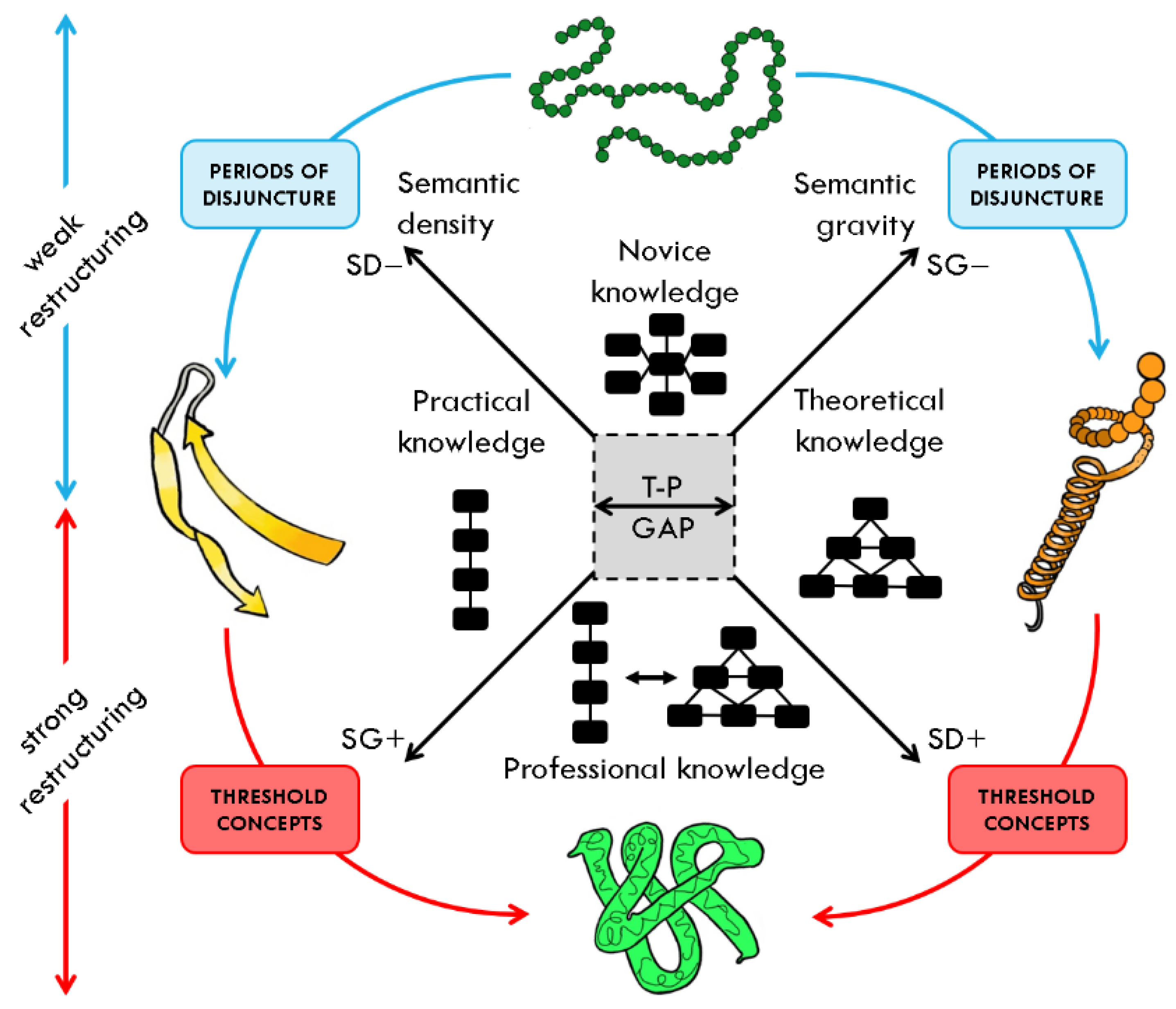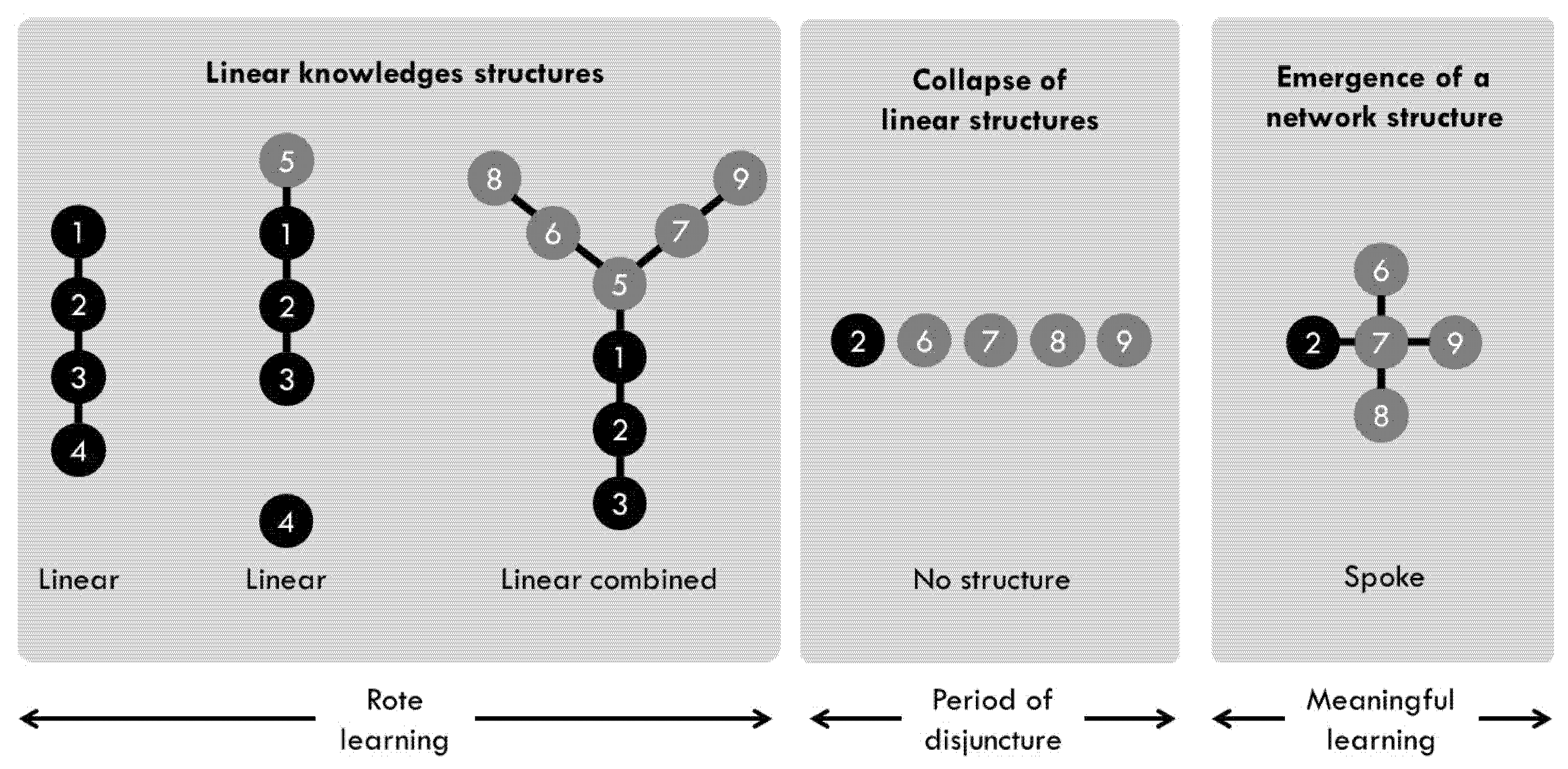Visualizing the Complexity of Knowledges to Support the Professional Development of University Teaching
Abstract
:1. Introduction
2. A Model from an Analogy of Protein Structure
2.1. An Unexpected Blackout to Contextualize Knowledge
The student in this case study began a course of learning with a simple prior-knowledge structure and learnt, at first, by rote addition. Later, however, they found that what was new was irreconcilable with what they had understood to begin with. The result was a period of ‘disjuncture’, during which the student was less able to explain the topic than they had been before. Eventually they achieved a new grasp of meaning, but this came after a difficult period in which they might easily have given up.[10] (p. 34)
2.2. Facing Hidden Mountains to Reach the Emergence of Expertise
The recognition of different knowledges has been described as essential for developing the basic characteristic of the expert student, who needs to recognize the existence and complementary purpose of different knowledge structures.[11] (p. 2)
A threshold concept represents a transformed way of understanding, or interpreting, or viewing something without which the learner cannot progress. As a consequence of comprehending a threshold concept there may thus be a transformed internal view of subject matter, subject landscape, or even world view. […] Such a transformed view or landscape may represent how people ‘think’ in a particular discipline, or how they perceive, apprehend, or experience particular phenomena within that discipline (or more generally).[13] (p. xv–xvi)
- Transformative: they result in a change in perception of a subject and may involve a shift in values or attitudes.
- Irreversible: the resulting change is unlikely to be forgotten.
- Integrative: it ‘exposes a previously hidden interrelatedness’ of other concepts within the discipline.
- Bounded: it serves to define disciplinary areas or to ‘define academic territories’.
- Potentially troublesome: students may have difficulty coping with the new perspective that is offered.
Stasis is required as part of the learning process: ‘lining up’ the segmental (beta sheets) and cumulative (alpha helices) knowledge structures for subsequent integration. […] The thresholds create moments of transformative change whilst the periods of conceptual stasis, rather than being ‘nothing’, are required to assemble the raw materials that will facilitate that change.[14] (p. 56–57)
- Semantic gravity (SG), i.e., the ‘degree to which meaning relates to its context’ [16] (p. 129). This can be relatively stronger (+) or weaker (−) along a continuum from theoretical to practical knowledge. Therefore, a concrete example of something tied to a particular context may be seen to exhibit a stronger semantic gravity (SG+) than a more abstract generalization derived from it (SG−).
- Semantic density (SD), i.e., ‘the condensation of meaning’ [16] (p. 129) that may be determined by socio-cultural practices, symbols, terms, concepts, phrases, gestures, actions, etc. Embedded within specialist texts or practices of a discipline, there are subtle meanings that are recognized by experts in the field but may be overlooked by novices who fail to appreciate the appropriate cues from what they may see as ‘technically heavy’ text.
- Weak restructuring is a gradual ‘accretion’ of new knowledge into an existing framework or the ‘tuning’ of an existing framework through the acquisition of constraining or limiting variables.
- Strong restructuring results from the introduction of powerful new organizing concepts that subsume existing ideas and forge fundamentally novel explanatory or descriptive frameworks of knowledge.
Epistemologically, weak restructuring may be viewed as a kind of ‘bottom-up’ process characterized by incremental, cumulative, and limited change, while strong restructuring is seen as a ‘top-down’ process of wholesale, abrupt, and extensive modification of the cognitive structure.[17] (p. 283)

2.3. Going beyond the Abyss to Find the Ecology of Knowledges
- Linear knowledge structures (chains) will exhibit ‘low recipience’, in that they do not support or encourage the formation of additional links to newly acquired information (i.e., reflecting a process of assimilation). This forces a period of disjunction.
- Networked knowledge structures will exhibit ‘high recipience’ (threshold concepts), in that they are receptive to the elaboration and are likely to support the development of new links (i.e., reflecting a process of accommodation).
- Rhizomatic knowledge structure (epistemologically singular): professional identity is formed as a result of the exploration of ‘high recipience’ in (b). Here, we have a period of ‘professional stasis’ when the academic is acting within the ‘known side’ of the abyss. The ‘excluded side’ and the existence of the abyss itself are not perceived.
- Rhizomatic knowledge structures (epistemologically plural) will exhibit the ‘highest recipience’ because the original rhizome becomes receptive to fit another rhizomatic structure of the excluded side of the abyss. The links to fit the rhizomes are part of a profound process of accommodation of knowledges from different academic cultures. The interdisciplinarity and transdisciplinarity involve this kind of change in knowledge structures. It is more challenging than it may appear beforehand. This may explain in part why it is difficult to implement interdisciplinary initiatives.
Author Contributions
Funding
Conflicts of Interest
References
- Healy, S. Epistemological pluralism and the ‘politics of choice’. Futures 2003, 35, 689–701. [Google Scholar] [CrossRef]
- de Sousa Santos, B. Epistemologies of the South: Justice against Epistemicide; Routledge: London, UK, 2014. [Google Scholar]
- Skopec, M.; Fyfe, M.; Issa, H.; Ippolito, K.; Anderson, M.; Harris, M. Decolonization in a higher education STEMM institution—Is ‘epistemic fragility’ a barrier? Lond. Rev. Educ. 2021, 19, 1–21. [Google Scholar]
- Wilson, E.O. Consilience: The Unity of Knowledge; Abacus: London, UK, 1998. [Google Scholar]
- Deleuze, G.; Guattari, F. A Thousand Plateaus (trans. Massumi, B.); Bloomsbury: London, UK, 1987. [Google Scholar]
- Novak, J.D. Learning, Creating, and Using Knowledge: Concept Maps as Facilitative Tools in Schools and Corporations, 2nd ed.; Routledge: New York, NY, USA, 2010. [Google Scholar]
- Novak, J.D.; Hoffman, R.R.; Moon, B.; Cañas, A.J. Applied Concept Mapping: Capturing, Analyzing, and Organizing Knowledge; CRC Press: Boca Raton, FL, USA, 2011. [Google Scholar]
- Correia, P.R.M. The use of concept maps for knowledge management: From classrooms to research labs. Anal. Bioanal. Chem. 2012, 402, 1979–1986. [Google Scholar] [CrossRef] [PubMed]
- Kinchin, I.M. Concept Mapping as a Learning Tool in Higher Education: A Critical Analysis of Recent Reviews. J. Contin. High. Educ. 2014, 62, 39–49. [Google Scholar] [CrossRef]
- Hay, D.; Kinchin, I.; Lygo-Baker, S. Making learning visible: The role of concept mapping in higher education. Stud. High. Educ. 2008, 33, 295–311. [Google Scholar] [CrossRef]
- Kinchin, I.M.; Möllits, A.; Reiska, P. Uncovering Types of Knowledge in Concept Maps. Educ. Sci. 2019, 9, 131. [Google Scholar] [CrossRef] [Green Version]
- Kinchin, I.M.; Thumser, A.E. Mapping the ‘becoming-integrated-academic’: An autoethnographic case study of professional becoming in the BioSciences. J. Biol. Educ. 2021, 1–12. [Google Scholar] [CrossRef]
- Meyer, J.; Land, R. Overcoming Barriers to Student Understanding: Threshold Concepts and Troublesome Knowledge; Routledge: New York, NY, USA, 2006. [Google Scholar]
- Kinchin, I.M. Solving Cordelia’s Dilemma: Threshold concepts within a punctuated model of learning. J. Biol. Educ. 2010, 44, 53–57. [Google Scholar] [CrossRef]
- Maton, K. Cumulative and Segmented Learning: Exploring the Role of Curriculum Structures in Knowledge-Building. Br. J. Sociol. Educ. 2009, 30, 43–57. [Google Scholar] [CrossRef]
- Maton, K. Knowledge and Knowers: Towards a Realist Sociology of Education; Routledge: London, UK, 2014. [Google Scholar]
- Mintzes, J.; Quinn, H.J. Knowledge restructuring in biology: Testing a punctuated model of conceptual change. Int. J. Sci. Math. Educ. 2007, 5, 281–306. [Google Scholar] [CrossRef]
- Kinchin, I.M.; Derham, C.; Foreman, C.; McNamara, A.; Querstret, D. Exploring the Salutogenic University: Searching for the triple point for the becoming-caring-teacher through collaborative cartography. Pedagogika 2021, 141, 94–112. [Google Scholar] [CrossRef]
- Kinchin, I.M.; Winstone, N.E.; Medland, E. Considering the concept of recipience in student learning from a modified Bernsteinian perspective. Stud. High. Educ. 2021, 46, 2296–2308. [Google Scholar]
- Young, M.; Muller, J. On the Powers of Powerful Knowledge. Rev. Educ. 2013, 1, 229–250. [Google Scholar] [CrossRef]





Publisher’s Note: MDPI stays neutral with regard to jurisdictional claims in published maps and institutional affiliations. |
© 2021 by the authors. Licensee MDPI, Basel, Switzerland. This article is an open access article distributed under the terms and conditions of the Creative Commons Attribution (CC BY) license (https://creativecommons.org/licenses/by/4.0/).
Share and Cite
Kinchin, I.M.; Correia, P.R.M. Visualizing the Complexity of Knowledges to Support the Professional Development of University Teaching. Knowledge 2021, 1, 52-60. https://doi.org/10.3390/knowledge1010006
Kinchin IM, Correia PRM. Visualizing the Complexity of Knowledges to Support the Professional Development of University Teaching. Knowledge. 2021; 1(1):52-60. https://doi.org/10.3390/knowledge1010006
Chicago/Turabian StyleKinchin, Ian M., and Paulo R. M. Correia. 2021. "Visualizing the Complexity of Knowledges to Support the Professional Development of University Teaching" Knowledge 1, no. 1: 52-60. https://doi.org/10.3390/knowledge1010006





